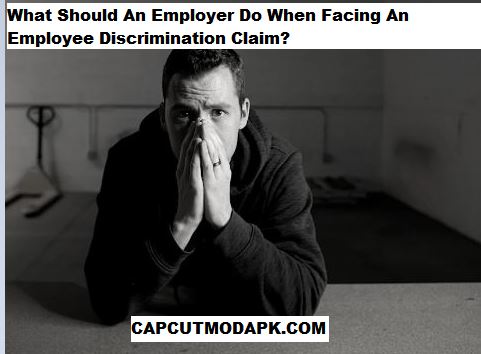Discrimination claims in the workplace are serious and can have long lasting impacts on a company’s reputation and financial stability. When faced with an employee discrimination claim, employers must respond swiftly and carefully to avoid potential legal consequences. “What should an employer do when facing an employee discrimination claim?” is a question that every business leader and HR professional should know the answer to. How they handle such a claim can determine whether the company faces a lawsuit, financial penalties, or damage to its reputation.
When an employee files a discrimination claim, they are alleging that they have been treated unfairly based on a protected characteristic, such as race, gender, age, or disability. Employers have a legal obligation to ensure that their workplace is free of discrimination. If an employer mishandles a discrimination complaint, it can lead to legal action and severe consequences. For any employer, understanding the necessary steps is crucial in navigating this complex issue.
In this article, we will explore “What should an employer do when facing an employee discrimination claim?” We will guide you through the essential actions that must be taken in response to such claims. From investigating the allegations to defending against the claims, every step is crucial to ensuring that employers comply with legal requirements while also protecting their business interests.
Also, READ
What Are My Rights If I Am Being Harassed At Work?
How Should an Employer Respond to an Allegation of Employment Discrimination?
When an employee brings a discrimination claim, the employer’s first step is to take the matter seriously. The initial response should be professional and thorough. Ignoring or dismissing a claim can make the situation worse and could result in legal trouble. “What should an employer do when facing an employee discrimination claim?” In response, the employer should ensure that an internal investigation is launched promptly. The investigation must be impartial, and the employer should try to gather facts without bias. This involves interviewing the accused party, the complainant, and any witnesses who may have observed the events leading to the discrimination claim.
It is also critical to ensure that the employee who filed the complaint is not retaliated against in any way. Retaliation for making a discrimination claim is illegal and can lead to further legal trouble for the employer. The employer should reassure the employee that the matter will be handled fairly and that retaliation will not be tolerated. It’s also important for the employer to keep the process confidential to protect the privacy of all involved parties and maintain the integrity of the investigation.
Once the investigation is complete, the employer should take appropriate action based on the findings. This could include disciplinary action against the employee responsible for the discriminatory behavior or implementing corrective actions, such as training or policy changes, to prevent future incidents. The employer should communicate the outcome of the investigation to both the complainant and the accused to maintain transparency and ensure the issue is resolved.
What to Do When Facing Discrimination at Work?

If an employee feels they are being discriminated against at work, they must first understand their rights and the proper steps to take. The first step is to report the discrimination internally to the employer. Many companies have policies in place for handling discrimination claims, and employees should follow the correct procedure. “What should an employer do when facing an employee discrimination claim?” is a crucial question for employees as well, as it is important for them to understand what to expect from their employer once the claim is filed.
Employees should document every instance of discrimination, including dates, times, locations, and details of what happened. Keeping a detailed record helps in building a solid case. If the discrimination is verbal, it’s essential to record the words used and the context in which they were said. If the discrimination is more subtle, such as a change in job responsibilities or a lack of promotion, employees should also document these events and make note of any patterns.
If the internal reporting process does not lead to a resolution, or if the employer does not take the matter seriously, employees may consider escalating the issue by filing a claim with the Equal Employment Opportunity Commission (EEOC) or the appropriate state agency. Taking these steps ensures that the discrimination issue is properly investigated and can lead to legal action if necessary. Employees should never feel afraid to take action against discrimination at work.
What Is an Employer’s Defense to an Employment Discrimination Claim?
Employers have several potential defenses when facing an employment discrimination claim. The first and most common defense is to argue that the alleged discrimination did not occur at all. This defense relies on disproving the employee’s version of events, often through contradictory evidence or witness testimony. The employer might also argue that the actions in question were not discriminatory but rather part of standard business practices or performance-based decisions.
Another defense is that the employer had a legitimate, non discriminatory reason for their actions. For example, an employer might argue that a particular decision, such as a promotion or firing, was based on the employee’s performance or business needs rather than any discriminatory factor. If the employer can demonstrate that their decision was based on valid and non-discriminatory reasons, the claim may not hold up in court.
Finally, employers can defend against a discrimination claim by proving that they took appropriate action to prevent discrimination and address any claims that were made. Employers who have a solid anti discrimination policy, conduct regular training, and handle complaints quickly and effectively may be able to argue that they made a good-faith effort to prevent and address discrimination in the workplace. This defense can be particularly important when defending against claims of a hostile work environment or retaliation.
What Step Should Be Taken After Receiving a Discrimination Complaint at a Workplace?
When an employer receives a discrimination complaint, the immediate step is to ensure that the matter is handled appropriately and efficiently. “What should an employer do when facing an employee discrimination claim?” The first step is to acknowledge the complaint, ensuring that the employee feels heard and taken seriously. This includes explaining the process the employer will follow to investigate the claim.
The next step is to assess the severity of the complaint. Employers should determine whether the complaint requires immediate action, such as placing the accused on leave during the investigation or providing accommodations to the complainant. It is also important to ensure that there is no retaliation against the employee who filed the complaint during the investigation process. Retaliation could lead to further legal issues for the employer.
Once the investigation begins, the employer should gather facts by speaking to all parties involved, including the accused and any witnesses. The employer should also review relevant documents, such as performance reviews, emails, or other communications that could shed light on the situation. After the investigation is complete, the employer must take appropriate action based on the findings, which may include disciplinary measures, policy changes, or additional training for employees.
How Do You Prove Unfair Discrimination at Work?
Proving unfair discrimination at work can be challenging, but it is possible with sufficient evidence. Employees need to document the discrimination clearly. This includes keeping a detailed record of each discriminatory incident, including dates, times, locations, and any witnesses who were present. Employees should also save any related emails, texts, or other communications that could support their claim.
In many cases, proving discrimination also requires demonstrating a pattern of behavior. One-off incidents may not be enough to constitute discrimination, but a pattern of discriminatory conduct can build a stronger case. Employees should also be aware of whether others in similar situations have experienced similar treatment. This can help establish that the discrimination is not isolated to a single person but part of a broader problem within the workplace.
In some cases, employees may need to rely on statistical evidence to prove discrimination, particularly in cases of hiring, firing, or promotion discrimination. For example, if a company consistently hires individuals from one demographic group while excluding others, this could be seen as evidence of discriminatory practices. A detailed investigation can help identify these patterns and build a strong case for discrimination.
What Are the Odds of Winning an EEOC Complaint?
The odds of winning an EEOC complaint depend on several factors, including the strength of the evidence, the nature of the claim, and the employer’s response. The EEOC investigates complaints of discrimination in both public and private workplaces. However, not all claims result in favorable outcomes for employees. According to EEOC data, only a small percentage of cases lead to financial settlements or rulings in favor of the complainant. The EEOC often attempts to resolve claims through mediation or conciliation before moving to litigation, which can be a time-consuming process.
One of the most critical factors in determining the success of an EEOC complaint is the quality of the evidence provided. Strong documentation, witness testimony, and a clear pattern of discriminatory behavior can significantly increase the chances of success. On the other hand, if the evidence is weak or there is no clear link between the alleged discrimination and the employee’s treatment, the chances of winning the complaint are lower.
Employers who are proactive in preventing discrimination and handling complaints properly may have a better chance of avoiding a negative outcome in an EEOC complaint. By addressing issues quickly, conducting thorough investigations, and maintaining a non-discriminatory workplace, employers can reduce the odds of facing a costly lawsuit or other legal consequences.
Conclusion
“What should an employer do when facing an employee discrimination claim?” The answer is clear: respond promptly, thoroughly, and fairly. Employers must investigate claims without bias, protect the employee from retaliation, and take appropriate action based on the findings. Failing to handle discrimination claims correctly can lead to legal troubles, damage to the company’s reputation, and financial losses.
It’s critical for employers to understand their responsibilities and take swift action when faced with a discrimination claim. This includes documenting the situation, conducting an impartial investigation, and addressing the underlying issue. By doing so, employers can protect both their employees and their business from the potential fallout of discrimination claims.


